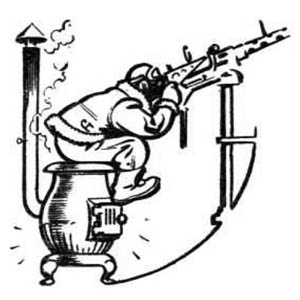Tips from bomber gunners to prevent guns and gunners from freezing during missions from a special edition of Army Talks, “Stars over the Reich,” published for the officers and men of the Eighth Air Force.
WORDS FROM THE WING WISE These tips on preventing frozen guns and gunners come from gunners who were on operations last winter.
How to Keep Your Guns from Freezing
Thorough cleaning before and after every mission is point number one. Remove all moisture and powder deposits, especially from the bolt recesses. Firing pin port and receiver (especially extractor switch recess and front barrel bearing) should be thoroughly cleaned, dried and then properly oiled with AXS 777 (new specification number—2-120). Leave only a light film of oil. And keep oil cans tightly closed to keep out dust and foreign matter.
A canvas bag will keep recoiling parts dry while they’re being carried to the plane.
Charge your gun just before or just after take-off (whichever is your Group’s policy). If your gun freezes when unloaded you’re stuck. If it’s loaded the recoil will loosen any frozen parts.
Test-fire at bombing altitude. If you can charge the gun but it won’t fire, hold the trigger back while the parts slam forward into battery—this sometimes loosens frosted parts. Only charge the gun when you have to; it lets cold moist air in to the recoiling parts. If the extractor switch is frozen, charging may result in an out-of-battery stoppage.
How to Keep Yourself from Freezing
Use the correct equipment and wear clothing as it says on the posters. Clothing should fit loosely, as air insulates, and your blood circulates better.
Keep dry. If your feet get wet, change your socks before take-off. Don’t Work around the plane in too heavy clothing before take-off, as sweat increases the danger of frostbite.
Pre-flight your heated suit. The connection in the plane may be out of order. Only turn your heated-suit rheostat up far enough so you are just warm enough to keep you from being miserable. Be sure to have fleece-lined clothing in case the suit goes permanently out of order. If it does, keep moving the parts of your body that don’t have heat, flexing the muscles, wiggling your fingers and toes. And it’s a good idea to have extra heated gloves and cords.
Wear mufflers or bath towels around your knees, neck and anywhere else that gets cold. Goggles and canvas or wool hoods are available, and they sure are handy if the plexiglass is broken near you.
If you have to take off your heated glove at altitude don’t remove the glove liner. Don’t leave any part of your body exposed for more than a few seconds. Remember, at 40 below zero you may freeze a hand badly enough to lose a finger before you feel any pain or realize anything’s wrong.










